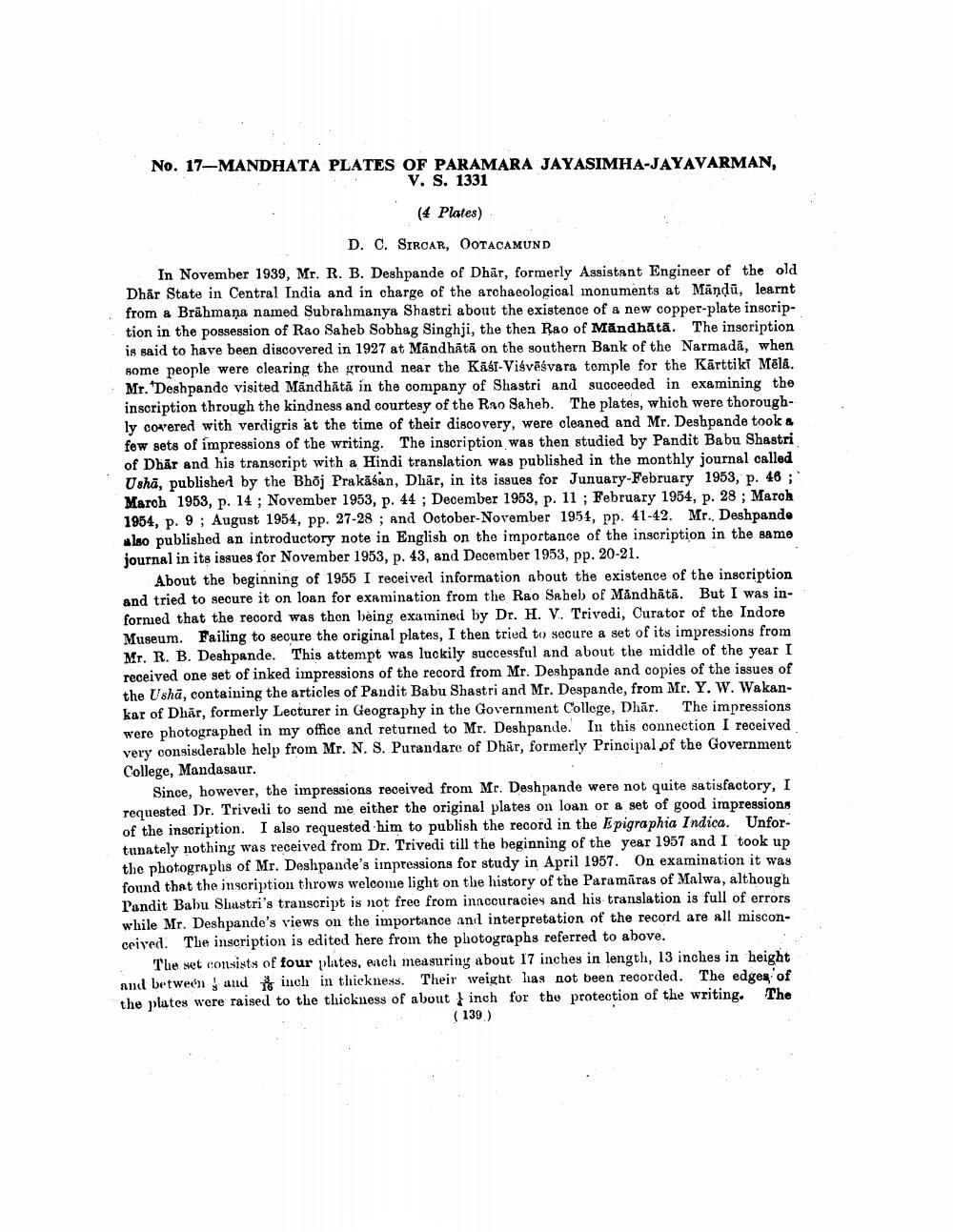________________
No. 17-MANDHATA PLATES OF PARAMARA JAYASIMHA-JAYAVARMAN,
V. S. 1331
(4 Plates)
D. C. SIRCAR, OOTACAMUND In November 1939, Mr. R. B. Deshpande of Dhår, formerly Assistant Engineer of the old Dhär State in Central India and in charge of the archaeological monuments at Mandū, learnt from a Brāhmana named Subrahmanya Shastri about the existence of a new copper-plate inscription in the possession of Rao Saheb Sobhag Singhji, the then Rao of Mandhātā. The inscription is said to have been discovered in 1927 at Māndhätä on the southern Bank of the Narmadā, when some people were clearing the ground near the Kāsi-Visvēsvara temple for the Kärttiki Mēlā. Mr. "Deshpande visited Māndhātă in the company of Shastri and succeeded in examining the inscription through the kindness and courtesy of the Rao Saheb. The plates, which were thoroughly covered with verdigris at the time of their discovery, were cleaned and Mr. Deshpande took & few sets of impressions of the writing. The inscription was then studied by Pandit Babu Shastri of Dhär and his transcript with a Hindi translation was published in the monthly journal called Usha, published by the Bhoj Prakasan, Dhār, in its issues for Junuary February 1953, p. 48 ; March 1953, p. 14 ; November 1953, p. 44 ; December 1953, p. 11 ; February 1954, p. 28; March 1954, p. 9; August 1954, pp. 27-28 ; and October-November 1954, pp. 41-42. Mr. Deshpando Also published an introductory note in English on the importance of the inscription in the same journal in its issues for November 1953, p. 43, and December 1953, pp. 20-21.
About the beginning of 1955 I received information about the existence of the inscription and tried to secure it on loan for examination from the Rao Saheb of Måndhātā. But I was informed that the record was then being examined by Dr. H. V. Trivedi, Curator of the Indore Museum. Failing to secure the original plates, I then tried to secure a set of its impressions from Mr. R. B. Deshpande. This attempt was luckily successful and about the middle of the year I received one set of inked impressions of the record from Mr. Deshpande and copies of the issues of the Ushā, containing the articles of Pandit Babu Shastri and Mr. Despande, from Mr. Y. W. Wakankar of Dhär, formerly Lecturer in Geography in the Government College, Dhär. The impressions were photographed in my office and returned to Mr. Deshpande. In this connection I received very consisderable help from Mr. N. S. Purandare of Dhär, formerly Principal of the Government College, Mandasaur.
Since, however, the impressions received from Mr. Deshpande were not quite satisfactory, I requested Dr. Trivedi to send me either the original plates on loan or a set of good impressions of the inscription. I also requested him to publish the record in the Epigraphia Indica. Unfortunately nothing was received from Dr. Trivedi till the beginning of the year 1957 and I took up the photographs of Mr. Deshpande's inpressions for study in April 1957. On examination it was found that the inscription throws welcome light on the history of the Paramāras of Malwa, although Pandit Babu Shastri's transcript is not free from inaccuracies and his translation is full of errors while Mr. Deshpande's views on the importance and interpretation of the record are all misconceived. The inscription is edited here from the photographs referred to above.
The set consists of four plates, each measuring about 17 inches in length, 13 inches in height and between und inch in thickness. Their weight las not been recorded. The edges of the plates were raised to the thickness of about inch for the protection of the writing. The
(139)




